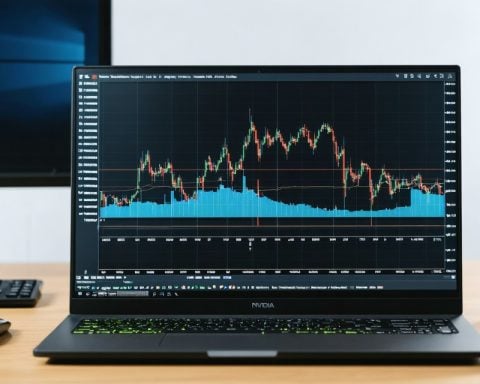- A “death cross” pattern, marked by the MVRV ratio falling below its 200-day moving average, is reappearing on Dogecoin’s price chart, causing concern among investors.
- Historically, this pattern has led to substantial price declines, with previous drops of 26% and 44% occurring after its appearance.
- The current price of Dogecoin hovers around $0.268, with a high MVRV ratio indicating many holders have significant unrealized gains.
- The market’s precarious setup may lead to increased volatility, but a potential rally above $0.44 offers hope for a positive shift.
- Investors face a pivotal decision: to maintain their positions or prepare for possible declines, as the situation demands careful analysis and vigilance.
Dogecoin enthusiasts face fresh apprehensions as a critical technical formation—ominously dubbed a “death cross”—reemerges on the crypto’s price chart. This unsettling indicator, revealed by analyst Ali Martinez, involves the Market Value to Realized Value (MVRV) ratio crossing beneath its 200-day moving average. Historically, such a confluence foretold grim corrections in price, sending shudders through the community.
In a tapestry of price lines and ratios, Martinez captures three intersecting paths: Dogecoin’s market price, its MVRV ratio, and the 200-day MVRV moving average. Each line tells a story of market sentiment, where numbers meet nerves. The past two instances where this “death cross” emerged, Dogecoin’s value slid dramatically, with declines of 26% and then 44%.
This foreboding pattern casts long shadows over Dogecoin’s current trading levels, which now teeter around $0.268. The MVRV ratio, a stark 91%, hints that many holders sit on substantial unrealized gains. Yet, the precarious nature of this setup suggests freshly brewed volatility may soon spill into the market.
But history is not a prophecy. For those doggedly optimistic, a rally above $0.44, and through formidable resistances marked by Fibonacci retracements, remains the beacon. As Dogecoin bucks beneath unseen pressure, eyes remain fixed on that elusive breakout—a chance to flip the script.
Investors, it seems, stand at a crossroads: Hold on or brace for a drop? This technical advisory serves not just as a warning but a call to action, urging vigilance in a world where real value and market whims perform a delicate dance.
The Death Cross Dilemma: Should Dogecoin Investors Hold or Fold?
Understanding the Death Cross in Crypto Markets
The term “death cross” is a technical chart pattern that occurs when a short-term moving average crosses below a long-term moving average. In the case of Dogecoin, this involves the Market Value to Realized Value (MVRV) ratio crossing beneath its 200-day moving average. Historically, this indicator has been a harbinger of declining prices, often followed by significant drops. Here, we explore possible implications, market trends, and strategic advice for Dogecoin investors.
Features & Specs: MVRV and Moving Averages
1. MVRV Ratio: This ratio compares the market value of a cryptocurrency to its realized value. A high MVRV ratio often signals that the asset is overvalued, suggesting near-term corrections.
2. 200-day Moving Average: A critical long-term trend line that helps analysts determine the general direction of an asset’s price. A cross beneath this line often signals bearish momentum.
Potential Market Reactions and Real-World Use Cases
– Market Volatility: Should the forecasted downturn occur, expect significant price fluctuations, which can be both a risk and an opportunity.
– Use Case for Traders: Day traders may find volatile markets lucrative, seeking to profit from short-term price swings during periods of price decline.
– Long-Term Investment Potential: Dogecoin, often driven by community support and celebrity endorsements, may still perform well in the long run, despite short-term corrections.
Market Forecasts & Industry Trends
– Adoption and Utility: Dogecoin’s success heavily depends on its adoption as a payment method and its utility in the digital economy. Companies like Tesla accepting Dogecoin can bolster its position.
– Regulatory Scrutiny: Expect increased regulatory scrutiny on cryptocurrencies, which might impact Dogecoin’s trading and adoption.
Reviews & Comparisons: Pros & Cons
Pros
– Community Support: A strong, active community backing can provide resilience against market downturns.
– Celebrity Endorsements: Public endorsements often lead to temporary price increases and renewed interest.
Cons
– Speculative Nature: Price is driven more by market sentiment rather than intrinsic value.
– Technological Limitations: Comparatively fewer use-case opportunities when juxtaposed with other blockchain technologies like Ethereum or Cardano.
Controversies & Limitations
– Volatility and Unpredictability: Dogecoin’s price can be highly volatile, which may deter risk-averse investors.
– Centralization of Holdings: A large portion of Dogecoin is held by few wallets, potentially leading to market manipulation.
Expert Insights & Predictions
Financial experts suggest maintaining diversification in cryptocurrency portfolios to manage risk effectively. Analysts caution against significant exposure to volatile assets like Dogecoin without a robust risk management strategy.
Actionable Recommendations for Dogecoin Investors
1. Risk Assessment: Continuously evaluate your risk tolerance when holding Dogecoin, particularly in highly volatile markets.
2. Diversification: Spread investments across multiple cryptocurrencies and asset classes to minimize risk.
3. Stay Informed: Keeping abreast of market news, regulatory changes, and technical indicators can offer strategic insights for timely decision-making.
4. Consider Stop-Loss Orders: Implementing stop-loss orders can help limit potential losses in a downtrend market.
5. Community Engagement: Engage with the Dogecoin community to understand market sentiment and upcoming trends.
For further insights and strategies about managing cryptocurrency investments, visit Coindesk or Cointelegraph.
By understanding the dynamics at play with Dogecoin and the broader crypto market, investors can better prepare for future market scenarios, making informed decisions that align with their financial goals.


















